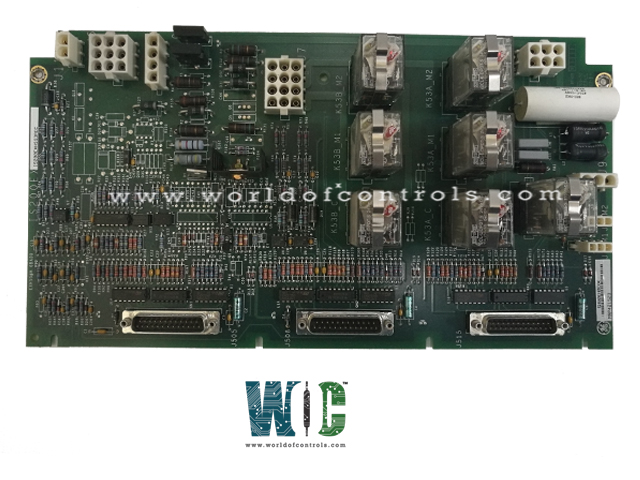
World Of Controls understands the criticality of your requirement and works towards reducing the lead time as much as possible.
IS200EXHSG3 - Exciter High-Speed Relay Driver Board is available in stock which ships the same day.
IS200EXHSG3 - Exciter High-Speed Relay Driver Board comes in UNUSED as well as REBUILT condition.
To avail our best deals for IS200EXHSG3 - Exciter High-Speed Relay Driver Board, contact us and we will get back to you within 24 hours.
SPECIFICATIONS:
Part No: IS200EXHSG3
Manufacturer: General Electric
Product Type: Exciter High-Speed Relay Driver Board
Series: EX2000
Number of Channels: 6
Power to Contacts: 125 V dc
Input Voltage: 120V AC
Output Voltage: 5V to 24V DC
Relay Break Characteristic: 28 V dc
Operating Voltage Range: 90V to 265V AC
Signal Feedback Input/Output: Analog (4-20mA)
Communication Protocols: Modbus
Operating Temperature: 0°C to 60°C
Mounting: DIN-Rail
Availability: In stock
Weight: 2.00 lbs
Size: 3.4 in x 6.37 inch
Country of Origin: USA
Manual: GEI-100475A
FUNCTIONAL DESCRIPTION:
IS200EXHSG3 is an Exciter High-Speed Relay Driver Board manufactured and designed by General Electric and is part of the EX2000 Series used in GE Excitation turbine control systems. This board is used in the EX2100 Excitation Control and provides drivers for the dc contactors (41), and pilot relays for de-excitation and field flashing. These boards cable to three IS200EMIO Exciter Main Input/Output Boards (EMIO, redundant control) or one EMIO board (simplex control) through the IS200EBKP Exciter Backplane Board (EBKP). Pilot relays for the flashing relays 53A and 53B are located on the board and for the de-excitation relay KDEP. De-excitation status signals from the IS200EDEX Exciter De-Excitation Board (EDEX) are conditioned on EXHS and sent to EMIO. Crowbar status signals from the De-Excitation Control Board (EXDE) are conditioned on EXHS and sent to EMIO. Three contact inputs from 41, 53A, and 53B are powered by 70 V dc on EXHS and the feedback is monitored. Power for the contacts is wired in from the exciter power supply. The resulting status signals are sent to the EMIO.
RELAY CONTROL:
For simplex control, EXHSG2 and EXHSG4 control two flashing relays. The pilot relays on EXHS are powered by 24 V dc from the M1 controller. Each flashing relay is driven by one pilot relay using two series contacts. Each EXHS contains two 41 dc contactor drivers controlled by a driver on EMIO. This driver on EMIO requires a command from the Field Programmable Gate Array (FPGA) and the 86G contact to be closed before energizing the driver. The FPGA or the 86G contact can cause the driver to de-energize. For redundant control, EXHSG1, EXHSG3, and the three inputs from controller M1, M2, and C control three relays connected in a 2-out-of-3 voting circuit. The relay coil is powered by 24 V dc from M1 and M2.
HIGH-SPEED CONTACTOR DRIVERS (K41A, K41B):
The high-speed contactor drivers on EXHSG1 and EXHSG2 provide a regulated constant sustaining current after initial contactor pickup. Full voltage (P125) is provided for 150 ms after recognizing an energize command. The regulated current mode begins at the end of this boost interval.
DE-EXCITATION CONDITIONING CIRCUIT:
In the simplex control, the conditioning circuit on EXHS monitors both inputs from the EDEX board, and if either input transitions, the conditioning circuit outputs to EMIO in M1. In the redundant control, the de-excitation signals from two EDEX are supplied to EMIO-M1 and EMIO-M2 through EXHS. There are two signal conditioning circuits on EXHS, one for each signal. The EXHS repeats the signal to EMIO.
CONTACT INPUTS:
Auxiliary contacts 53A, 53B, and 41 are brought into EXHS for monitoring on EMIO. The contact input uses are similar in the simplex and redundant cases, however, the inputs are fanned to the M1, M2, and C controllers for redundant control. In the simplex control, the signals only go to the EMIO in the M1 controller. The three contacts are wetted by 70 V dc supplied from EXHS. Power from plugs J12M1 and J12M2 is resistor isolated and supplied to the contacts. The wetting voltage can vary from 63 to 84 V dc. The resulting signal fans out to M1, M2, and C, and the contact input monitoring circuit is on EMIO.
WOC has the largest stock of OEM Replacement Parts for GE Excitation Control Systems. We can also repair your faulty boards and supply unused and rebuilt boards backed up with a warranty. Our team of experts is available round the clock to support your OEM needs. Our team of experts at WOC is happy to assist you with any of your automation requirements. For pricing and availability on parts and repairs, kindly contact our team by phone or email.
What is the Exciter High-Speed Relay Driver Board?
It is a relay driver board in GE’s EX2000/EX2100 systems. It controls DC contactors and pilot relays, and processes signal conditioning for turbine excitation control.
What series does the board belong to?
The board is part of General Electric’s EX2000 and EX2100 excitation system series, widely used in turbine control systems.
What are the board’s primary functions?
It drives DC contactors, manages de-excitation and field flashing relays, and conditions status signals for communication with other system components.
What configurations does the board support?
The board supports simplex configurations (single EMIO board) and redundant setups (three EMIO boards with voting logic for high reliability).